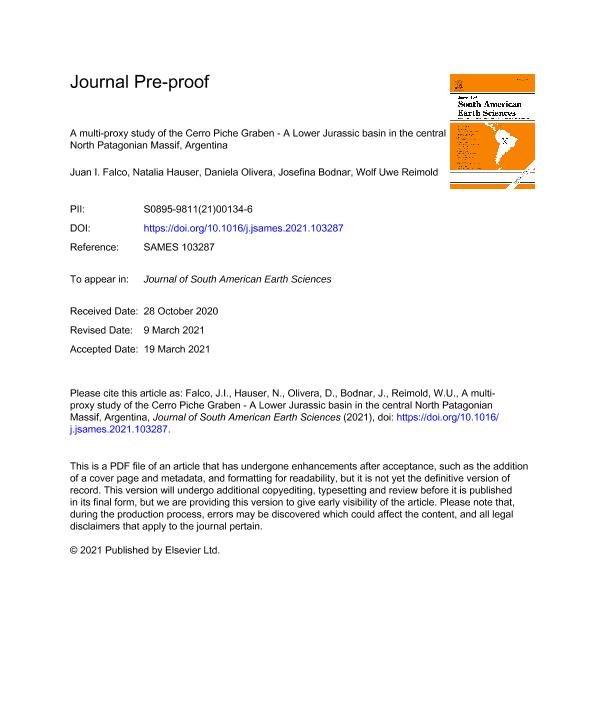Artículo
A multi-proxy study of the Cerro Piche Graben: a Lower Jurassic basin in the central North Patagonian Massif, Argentina
Falco, Juan Ignacio ; Hauser, Natalia
; Hauser, Natalia ; Olivera, Daniela Elizabeth
; Olivera, Daniela Elizabeth ; Bodnar, Josefina
; Bodnar, Josefina ; Reimold, Wolf Uwe
; Reimold, Wolf Uwe
 ; Hauser, Natalia
; Hauser, Natalia ; Olivera, Daniela Elizabeth
; Olivera, Daniela Elizabeth ; Bodnar, Josefina
; Bodnar, Josefina ; Reimold, Wolf Uwe
; Reimold, Wolf Uwe
Fecha de publicación:
08/2021
Editorial:
Pergamon-Elsevier Science Ltd
Revista:
Journal of South American Earth Sciences
ISSN:
0895-9811
Idioma:
Inglés
Tipo de recurso:
Artículo publicado
Clasificación temática:
Resumen
The volcano-sedimentary succession of the Cerro Piche Graben, Río Negro province, Patagonia (Argentina), was studied U-Pb and Lu-Hf in zircon. As well, a stratigraphic, sedimentological, palynology and a review of the paleo flora content was made. The combined stratigraphic and geochronological study on the volcano-sedimentary succession indicates that the Cerro Piche Graben was developed during the Early Jurassic and allow us to propose the Cerro Piche Formation. This formation is composed of a lower volcanic succession (named the Loma Blanca Member) that is restricted to the tectonic depression and that was probably emplaced during the Sinemurian (ca. 191 Ma), and an upper sedimentary succession (named the El Tono Member) that was unconformably deposited over the lower sequence during the Pliensbachian (ca. 183 Ma). The sedimentological study of the upper sequence allows to recognition of nine sedimentary cycles related to the evolution of an alluvial fan. The palynofacies interpretations reflect intermittent exposure to weathering and/or intense reworking of organic components as a result of a dynamic sedimentary system with a high terrestrial input, sediment reworking, and/or intermittent subaerial exposure. The paleoflora preserved in this sedimentary succession is composed exclusively of conifers and assigned to Cupessinoxylon sp., and probably corresponds to an arboreal paleocommunity. The U-Pb data on Early Jurassic detrital zircon grains from the El Tono Member indicate a maximum depositional age (MDA) of 185 Ma for this sequence, and the Lu-Hf data support a reworked continental crust for the zircon source. . Additionally, the U-Pb and Lu-Hf data obtained during this work together with data from the North Patagonian Massif supports the recognition of four magmatic cycles, called C0, C1 (including C1i source), C2 and C3. The C1 (172-180 Ma) and the C3 (155-162 Ma) cycles indicate mixing of juvenile mantle-42 derived and reworked crustal components in the parental magma of zircons and the C0 (182-192 Ma) cycle, which includes the distal volcanism identified in the Cerro Piche Graben, the C1i (172-180 Ma) and C2 (166-169 Ma) cycles seemingly represent three episodes of crustal reworking.
Archivos asociados
Licencia
Identificadores
Colecciones
Articulos(IIDYPCA)
Articulos de INST. DE INVESTIGACIONES EN DIVERSIDAD CULTURAL Y PROCESOS DE CAMBIO
Articulos de INST. DE INVESTIGACIONES EN DIVERSIDAD CULTURAL Y PROCESOS DE CAMBIO
Articulos(INGEOSUR)
Articulos de INST.GEOLOGICO DEL SUR
Articulos de INST.GEOLOGICO DEL SUR
Citación
Falco, Juan Ignacio; Hauser, Natalia; Olivera, Daniela Elizabeth; Bodnar, Josefina; Reimold, Wolf Uwe; A multi-proxy study of the Cerro Piche Graben: a Lower Jurassic basin in the central North Patagonian Massif, Argentina; Pergamon-Elsevier Science Ltd; Journal of South American Earth Sciences; 109; 8-2021; 1-78
Compartir



